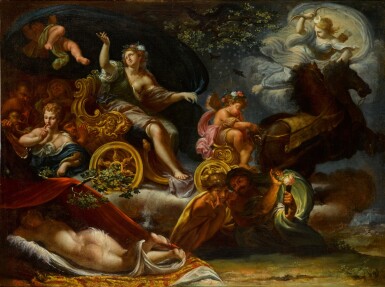Auctions
Buy Now
Collectibles & More
Books & Manuscripts
Old Masters Day Sale, including portrait miniatures
Old Masters Day Sale, including portrait miniatures

The Property of a European Private Collector
An Allegory of Night
Lot Closed
December 8, 03:27 PM GMT
Estimate
20,000 - 30,000 GBP
Lot Details
Description
The Property of a European Private Collector
Italian School, circa 1700
An Allegory of Night
oil on canvas
unframed: 100 x 136.5 cm.; 39⅜ x 53¾ in.
framed: 109.1 x 144 cm.; 43 x 56⅝ in.
‘Night, embracing the labors of earth and sky, you send forth the fiery stars on their wandering courses, granting renewal to the spirit until the next Titan pours its enlivening sunrise onto feeble spirits’, Statius, Thebaid, 80–90AD.1
This fascinating painting is an allegory of Night, depicted here on a cloud as a female figure in a horse-drawn chariot driven by a sleeping putto. Giovanni Boccaccio in his Genealogy of the Pagan Gods, describes her as the first child of the Earth, dressed in a dark cloak which she draws across the world, indicator of the night sky.2 A century later, in Ripa’s Iconologia she is described as a female figure in a chariot drawn by black horses, alluding to the darkness of the night, and crowned with a garland of poppies, signifiers of slumber.3
Here, she is surrounded by two putti, possibly her children, Sleep and Death, often depicted alongside her. Beneath her, to the left of the composition, are various figures, most of which have succumbed to slumber. Among them is a young man with his finger over his lips, inviting the viewer to silence. This is Harpocrates, god of silence. In the top right corner, the goddess of the moon and the stars, Diana floats in the sky. In the foreground, beneath a branch on which hangs a red curtain, lies a sleeping female figure. Her pose is certainly inspired by the antique ancient sculpture of the Sleeping Hermaphroditus conserved at the Louvre, which was discovered in the first decades of the seventeenth century, entering the collection of Cardinal Scipione Borghese in Rome.4 In the centre of the composition, beneath the cloud emerge two figures, one pointing to his eye, the other holding a torch. Their identification remains a mystery; however, it has been suggested they might represent the dangers of the night, inviting the viewer to caution. In fact, it would appears that part of the red curtain covering the sleeping figure is on fire. This aspect is alluded to by Boccaccio, who mentions that the night suits those who do evil and ‘to murder men thieves rise at night’.5
The attribution of this allegorical scene remains elusive. Nevertheless, it seems likely that it was painted by an Italian artist, possibly in Rome, who was familiar with the writings of Cesare Ripa and Giovanni Boccaccio, and who had seen the ancient sculpture of the Sleeping Hermaphroditus.
We are grateful to Dr Paul Taylor and Professor Elizabeth McGrath for their assistance in cataloguing this lot.
1 Statius, Thebaid, 80–90 AD, Book 1, quoted in G. Boccaccio and J. Solomon (eds), The Genealogy of the Pagan Gods, vol. 1, book 1, Cambridge, MA, and London 2011, p. 91.
2 G. Boccaccio, Genealogia de gli Dei, Venice 1554, vol. 1, book 1, pp. 44–46.
3 C. Ripa, Iconologia, Venice 1645, pp. 81–82 and 438–42.
4 Inv. no. Ma 231.1; White marble; 46.5 x 173.5 x 90.5 cm.; https://collections.louvre.fr/ark:/53355/cl010250571
5 Boccaccio and Solomon 2011, p. 95.